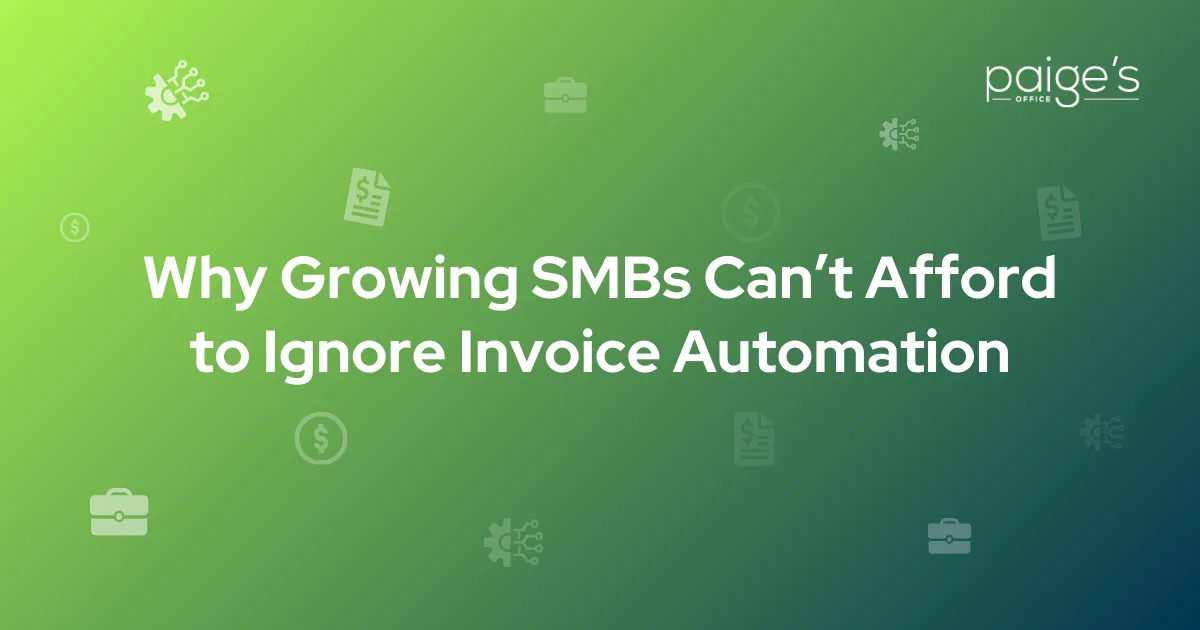
Why Growing SMBs Can’t Afford to Ignore Invoice Automation
In 2024, 62% of companies found themselves speeding up their payments and enjoying healthier cash flow thanks to accounts receivable (AR) automation. This shows that, since 2024, more businesses are turning to automated tools to make sure invoices get paid on time.
For small and medium-sized businesses (SMBs), dealing with invoicing the old-fashioned way (manually chasing after payments) can be pretty time-consuming and often leads to slip-ups. But with invoice automation, those tedious tasks are taken care of automatically. This means businesses can get their money quicker and have more time to focus on what really matters: growing their brand and taking care of their customers.
In this blog, we’ll explain what invoice automation is, how it’s different from basic digital invoicing, the impact it can have on your business, and clear up some common myths that may be holding SMBs back.
What is Invoice Automation?
Invoice automation uses software, often powered by artificial intelligence (AI), to handle your accounts receivable process from start to finish. This includes creating and sending invoices, following up on overdue payments, reconciling accounts, and even sending reminders to clients automatically.
Unlike manual methods, invoice automation ensures accuracy, speeds up the payment process, and reduces the workload on your finance team. With modern solutions, you can integrate it with your existing accounting or CRM systems, making it a seamless part of your operations.
Difference Between Automation and Basic Digital Invoicing

It’s easy to confuse invoice automation with simple digital invoicing tools like PDF templates or email-based billing systems. But they’re not quite the same.
Basic Digital Invoicing: Lets you create and send invoices electronically, often as email attachments. It’s faster than paper-based methods but still requires manual follow-ups, reminders, and record-keeping.
Invoice Automation: Goes beyond sending invoices. It automatically tracks due dates, sends payment reminders, follows up on overdue accounts, and updates records in real-time. It can also integrate with multiple communication channels—email, SMS, and even phone calls, ensuring a higher collection rate.
In short, basic digital invoicing saves you some time. Invoice automation saves you a lot of time, reduces errors, and directly impacts your cash flow.
The Business Impact
Before we break down the specific challenges, it’s important to understand that inefficient invoicing doesn’t just slow down your admin work, it can directly limit your ability to grow. From delayed payments to strained client relationships, the ripple effects touch every part of your business. Here’s how:
1. Slower Payments and Cash Flow Crunch
Late payments are one of the biggest pain points for growing SMBs.
Manual tracking means you often discover overdue invoices only after they’ve been overdue for weeks. Without consistent follow-ups, payments get delayed, and your cash flow suffers.
Invoice automation keeps the process running 24/7.
Reminders go out automatically, overdue accounts get flagged instantly, and your team can address issues before they escalate, helping you keep cash coming in regularly.
2. Higher Error Rates and Costly Corrections
Manual data entry leaves plenty of room for human error, wrong amounts, incorrect client details, or missed invoices.
Fixing these mistakes takes time and sometimes damages your credibility with clients.
Automation minimizes these risks by pulling accurate data directly from your accounting system, generating invoices automatically, and ensuring every detail is correct before it goes out.
3. Lost Time That Could Be Spent on Growth
Every hour your team spends chasing invoices is an hour not spent on revenue-generating activities, like acquiring new customers, refining your services, or exploring new markets.
With automation, repetitive tasks like sending reminders or updating payment records happen without human intervention, freeing your staff to focus on strategic growth activities.
4. Strained Client Relationships
Nobody enjoys being chased for payments, and manual follow-ups can sometimes feel inconsistent or overly aggressive.
When communication isn’t managed carefully, it can strain otherwise good relationships.
Automation tools use polite, professional, and consistent messaging, customized to match your brand voice.
This ensures reminders are timely and respectful, preserving your client relationships while still encouraging prompt payment.
How Invoice Automation Drives Growth

Invoice automation gives SMBs the speed, accuracy, and visibility needed to handle more business without increasing costs or stress.
Here’s what it brings to the table:
Faster Payments: Automated follow-ups mean invoices are paid sooner, improving cash flow and giving you more capital to invest in growth.
Better Financial Visibility: Real-time tracking helps you forecast revenue, plan budgets, and make smarter financial decisions.
Scalability: As your client base grows, automation can handle the increased workload without adding extra staff.
Integration with Business Tools: Connects with CRM, ERP, and accounting platforms for a streamlined workflow.
24/7 Operation: Automation works around the clock, ensuring no invoice slips through the cracks.
Common Myths Holding SMBs Back
Many SMBs delay adopting invoice automation because they believe it’s expensive, complex, or unnecessary.
In reality, these myths are holding them back from faster payments, smoother operations, and better cash flow. Let’s clear them up:
“It’s only for big companies.”
Modern invoice automation tools are affordable and designed for businesses of all sizes, including SMBs.
“It’s too complicated to set up.”
Most platforms are user-friendly and integrate directly with your existing systems, requiring minimal training.
“My clients won’t like it.”
Automation doesn’t mean robotic communication. You can customize reminders and messages to sound personal and on-brand.
“It’s an unnecessary expense.”
The cost of invoice automation is often offset by faster payments, reduced errors, and time saved. In many cases, it pays for itself within months.
The Cost of Waiting
For growing SMBs, sticking with manual or basic digital invoicing might feel comfortable, but it’s also risky.
The longer you wait to automate, the more time, money, and opportunities you lose to slow payments, errors, and inefficiencies.
Invoice automation offers a smarter approach.
Solutions like Paige’s Office streamline reminders, follow-ups, and payment tracking, helping you maintain healthy cash flow, strengthen client relationships, and give your team more time to focus on growth.
Waiting only prolongs inefficiencies and missed opportunities, but taking action today ensures your business is ready to scale confidently into the future.

